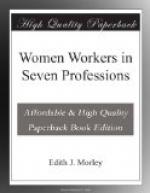Teachers in physically defective schools can also see the need for prevention of defect rather than its mere alleviation. The more usual forms of defect are missing limbs, tuberculous troubles (notably in joints), heart cases, paralysis, cases of chorea, and cases of general debility. The list must not be taken as complete, for there are, of course, various unusual forms of defect too. It sometimes happens that after a stay of some time in a physically defective school, a child becomes so much better that it is able to return to the greater strain of an ordinary school; on the other hand, it is often apparent, that if certain children had been admitted earlier to the physically defective school, their particular trouble might have been greatly minimised, if not altogether avoided. What then appears to be needed is an intermediary type of school to which children might be drafted who are not as yet absolutely defective, but who are liable to become so. Children of tubercular tendencies, who should be guarded against falls or blows more carefully than normal children; those highly-strung nervous children who, if exposed to the strain of ordinary school life run the risk of chorea; children suffering from the after-effects of diseases such as rheumatic or scarlet fever, who need particularly to avoid over-exertion or too violent exercise; children of such marked general debility that their power of resisting disease is abnormally low—all these, if neglected, tend to become qualified candidates for the physically defective schools. If they could attend a school designed to suit their needs, they would in many cases be quite able to return, after varying periods, to their places in the ordinary schools. The open-air schools are an attempt to meet this need on the very best lines, but there are far too many of these border-line children for the available accommodation. If the great expense entailed by new schools of this description be considered, it seems not unreasonable, while waiting for them, to allow the admission of these children to the invalid schools already working, by simply making the term “physically defective” elastic enough to include a latent as well as a developed defect. Whatever the apparent expense of such measures may be, any extension of the preventive side of this work cannot but be a real economy.[2]
There is just one other point for the consideration of women who think of taking up work in special schools. They should be thoroughly strong and healthy, or they will prove unequal to a strain which tells at times even on the strongest. But to women of good health who possess the right temperament, these schools offer a field of useful and congenial work.
[Footnote 1: Something in this direction will be achieved by the new Act, to which, however, there are counterbalancing grave objections which cannot be considered here. [EDITOR.]]
[Footnote 2: Open-air schools, and school sleeping camps such as those established experimentally in various urban slum-districts, are other efforts to meet the needs of physically defective children. Teachers in open-air schools in provincial towns, work under approximately similar conditions to those described by Mrs Thomas. [Editor.]]




